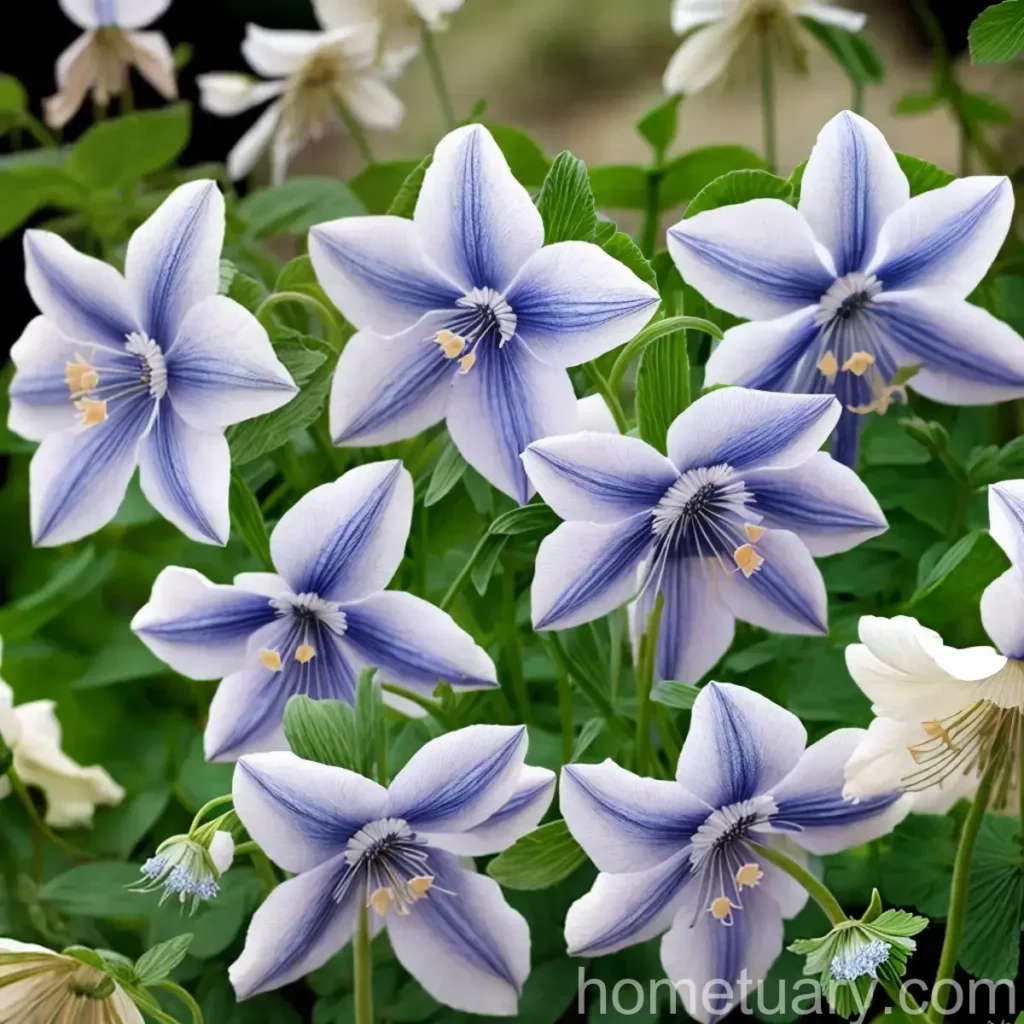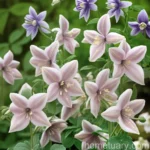The Enigmatic Columbine (Aquilegia caerulea)
The columbine plant, scientifically known as Aquilegia caerulea, is a captivating and versatile herbaceous perennial. Its unique, distinctive, spurred flowers make it a favorite among gardeners, horticulturists, and botanists. This article delves into the various aspects of this intriguing plant, including its cultural significance, uses, best cultivation practices, common pests and diseases, as well as botanist’s tips and fun facts.
What is columbine (Aquilegia caerulea)?
Columbine, or Aquilegia caerulea, belongs to the Ranunculaceae family and is native to North America. It is commonly referred to as the Rocky Mountain or Colorado blue columbine and is the state flower of Colorado. This perennial plant is known for its distinct flowers, which come in a range of colors, including shades of blue, lavender, white, and pink, often with contrasting petals and spurs.
Aquilegia caerulea typically grows up to two feet in height and displays attractive, delicate foliage. It thrives in temperate climates and is often found in mountain woodlands, meadows, and alongside streams and rocky slopes.
Key Takeaways – Columbine (Aquilegia caerulea)
Before delving into the specifics of the columbine plant, it is important to highlight some key takeaways for enthusiasts and gardeners looking to learn more about this fascinating species. These takeaways provide a comprehensive overview of essential aspects of Aquilegia caerulea, setting the stage for a deeper understanding of its cultivation, uses, and role in diverse ecosystems.
Key Takeaways
- The columbine (Aquilegia caerulea) is a herbaceous perennial native to North America, prized for its distinctive, spurred flowers and delicate foliage.
- It is commonly referred to as the Colorado blue columbine or Rocky Mountain columbine and is the state flower of Colorado.
- Columbine flowers come in various colors, including shades of blue, lavender, white, and pink, often showcasing captivating petal and spur contrasts.
- This plant thrives in temperate climates and is frequently found in mountain woodlands, meadows, and rocky slopes, contributing to the biodiversity of these habitats.
Culture
Understanding the cultural requirements of the columbine plant is crucial for its successful cultivation and propagation. From water and sunlight needs to soil and fertilizer preferences, providing an optimal cultural environment is essential for the health and vigor of Aquilegia caerulea. Let’s explore the cultural aspects in detail to ensure a thriving columbine garden or landscape.
Water
Columbine (Aquilegia caerulea) thrives in well-draining soil that remains consistently moist. However, it is crucial to strike a balance, as excessively wet soil can lead to root rot and other issues. Adequate watering during periods of dryness and ensuring proper drainage are essential for the health of the plant.
Aquilegia caerulea watering requirements
- Provide regular watering, especially during periods of drought or dry weather.
- Ensure the soil remains consistently moist but well-drained, avoiding waterlogging and root rot.
- Mulching the soil can help retain moisture and regulate the temperature, benefiting the overall health of the plant.
Sunlight
Columbine plants prefer partial shade to full sun, depending on the climate and local environmental conditions. In hotter regions, providing some shade during the hottest part of the day can prevent wilting and stress on the plant. Conversely, in cooler climates, they can tolerate more sunlight.
Aquilegia caerulea sun requirements
- Place columbine plants in an area with dappled sunlight or partial shade, especially in warmer regions.
- In cooler climates, they can tolerate more sunlight, but ensuring adequate moisture becomes even more critical in these conditions.
- Observing the plant’s response to sunlight and adjusting as needed can help optimize its growth and flowering.
Fertilizer
When it comes to fertilizing columbine (Aquilegia caerulea), a balanced approach is key. While they do not require heavy feeding, providing nutrients during the growing season can support healthy foliage and vibrant blooms. A balanced, water-soluble fertilizer is suitable for meeting the nutritional needs of the plant.
Best fertilizer for Aquilegia caerulea
- Use a balanced, water-soluble fertilizer diluted to half the recommended strength to avoid over-fertilization.
- Apply fertilizer in early spring as new growth emerges and then again in midsummer to sustain the plant’s vigor and blooming.
- Avoid excessive fertilizer application, as it can lead to lush foliage at the expense of flowers and may make the plant more susceptible to pests and diseases.
Soil
Optimal soil conditions are imperative for the successful cultivation of columbine (Aquilegia caerulea). A rich, well-draining soil that is slightly acidic to neutral generally suits the plant. Amending the soil with organic matter can improve its structure and fertility, providing an ideal foundation for the columbine to thrive.
Best soil for Aquilegia caerulea
- Opt for a rich, well-draining soil that is slightly acidic to neutral, such as loamy or sandy loam soil.
- Amend the soil with organic matter, such as compost or well-rotted manure, to enhance its fertility and structure.
- Regularly monitor the soil’s moisture levels and drainage, making adjustments as needed to maintain the optimal growing medium for the plant.
Pruning
Pruning columbine (Aquilegia caerulea) is relatively straightforward and primarily focuses on deadheading spent flowers and removing damaged or diseased foliage. This practice not only tidies up the plant but also encourages further blooming and prevents the spread of diseases.
How to prune columbine plants
- Deadhead spent flowers regularly to promote continuous blooming and prevent the formation of seeds, which can inhibit further flowering.
- Remove yellowing or diseased foliage promptly to maintain the plant’s overall health and vigor.
- Pruning is best done in early summer after the initial flush of flowering, allowing the plant to potentially produce a second wave of blooms.
Propagation
Aquilegia caerulea can be propagated through various methods, including seed sowing, division, and root cuttings. Each technique has its advantages and is suitable for different contexts, catering to the preferences of gardeners and horticulturists.
Columbine plant propagation tips
- Propagate columbine through seed sowing in late winter or early spring, providing a moist, well-draining seed-starting mix and maintaining consistent moisture and warmth for germination.
- Division is an effective method for propagating established columbine plants, typically performed in early spring, ensuring each division retains healthy roots and shoots for successful establishment.
- Root cuttings offer another propagation option, with the potential to generate new plants that closely resemble the parent plant, and can be undertaken in late winter or early spring.
Container Popularity
The versatility of columbine (Aquilegia caerulea) makes it well-suited for container gardening, adding a charming and colorful touch to patios, balconies, and other outdoor spaces. Its compact nature and attractive flowers and foliage make it a popular choice for container cultivation.
Columbine plant in containers
- Select a well-draining container with sufficient depth and width to accommodate the root system and promote healthy growth.
- Use a high-quality potting mix that offers good drainage and aeration, essential for container-grown plants.
- Regular watering and monitoring of moisture levels are crucial for container-grown columbine, as they may dry out more quickly than those in the ground.
Common Diseases
Columbine plants, while generally robust, can be susceptible to certain diseases that can impact their health and appearance. Identifying and addressing these issues promptly is crucial for maintaining the vitality and beauty of Aquilegia caerulea.
Disease diagnosis
-
Powdery Mildew: This fungal disease presents as a powdery, white coating on the leaves and stems, often leading to distorted growth and diminished plant vigor. Improving air circulation and avoiding overhead watering can help prevent powdery mildew.
-
Leaf Spot: Characterized by dark spots on the foliage, leaf spot can be caused by various fungal pathogens. Removing and disposing of affected leaves and providing adequate spacing between plants can help manage this disease.
-
Downy Mildew: Downy mildew appears as yellow to brown spots on the upper leaf surfaces, often accompanied by grayish-purple, fuzzy growth on the undersides. Avoiding overhead watering and providing proper air circulation can reduce the likelihood of downy mildew.
Common pests
In addition to diseases, columbine plants can also fall prey to certain pests that can impact their growth and overall health. Being vigilant and taking appropriate measures can help manage pest infestations effectively.
-
Aphids: These small, sap-sucking insects can cluster on new growth and flower buds, potentially causing distortion and stunted development. Pruning infested parts and using insecticidal soaps or horticultural oils can help control aphids.
-
Columbine Sawfly: The larvae of this sawfly species feed on columbine foliage, often causing significant damage. Handpicking and disposing of the larvae and using insecticidal soaps or neem oil can assist in managing this pest.
-
Columbine Leaf Miners: The larvae of leaf miner flies create squiggly mines within the leaves, impacting the plant’s aesthetic appeal. Removing and disposing of affected leaves and employing beneficial insects can aid in controlling leaf miner populations.
Botanist’s Tips
To delve deeper into the world of columbine (Aquilegia caerulea), let’s explore some valuable tips from botanists and experienced gardeners. These insights can offer practical guidance and enhance the understanding of this remarkable plant.
-
Companion Planting: Pairing columbine with complementary plants, such as foxgloves, salvia, and bleeding hearts, can create visually stunning and harmonious combinations in the garden. Additionally, selecting plants that thrive in similar cultural conditions can benefit the overall health and appearance of the garden.
-
Attracting Pollinators: Columbine’s intricate flowers and nectar can attract various pollinators, including bees, hummingbirds, and butterflies. Incorporating columbine into pollinator-friendly gardens can contribute to the conservation and well-being of these vital species.
-
Winter Care: In colder regions, providing a layer of mulch around the base of the plant can help insulate the roots and protect them from extreme temperatures. This practice is especially beneficial during the first winter after planting to ensure the plant’s establishment.
Fun Facts
Uncovering the fascinating and lesser-known aspects of columbine (Aquilegia caerulea) can add an extra layer of appreciation for this captivating plant. Let’s explore some intriguing fun facts that shed light on the unique characteristics and cultural significance of the columbine.
- The genus name “Aquilegia” is derived from the Latin word “aquila,” meaning eagle, referencing the shape of the flower’s petals and spurs resembling an eagle’s talons.
The presence of spurs in columbine flowers acts as a nectar guide, directing pollinators towards the nectar source and enhancing the plant’s reproductive success.
Columbine flowers have been associated with diverse symbolism, including love, gratitude, and femininity, and have appeared in various myths, folklore, and traditional medicine practices throughout history.
In conclusion, columbine (Aquilegia caerulea) captivates enthusiasts and botanists alike with its captivating flowers, adaptability, and cultural significance. By understanding its cultural requirements, potential diseases and pests, and leveraging botanist’s tips, gardeners can foster thriving columbine gardens and landscapes, further enriching their horticultural experiences.
The versatile nature of Aquilegia caerulea enables its inclusion in a range of environments, from woodland gardens and perennial borders to container settings, showcasing its adaptability and ornamental value. Embracing the allure of columbine and discovering its fascinating history and folklore adds depth to the gardening journey, making it a perennial favorite among plant enthusiasts and nature lovers.
Links to External Resources
As with any botanical pursuit, an eagerness to further explore and expand one’s knowledge is essential. Below are some external resources to aid in an in-depth exploration of columbine (Aquilegia caerulea) and related topics:
-
The American Columbine: Aquilegia caerulea – Learn more about the natural history, range, and cultural significance of Aquilegia caerulea.
-
Colorado State University Extension: Powdery Mildew on Ornamental Plants – Gain insights into managing powdery mildew, a common issue affecting columbine and other ornamental plants.
-
University of California Statewide Integrated Pest Management Program: Aphids – Explore information on aphids and effective management strategies to protect plants from infestations.
By delving into these resources and seeking a deeper understanding of columbine, enthusiasts can enrich their knowledge and appreciation for this remarkable plant, further enhancing their gardening endeavors.















